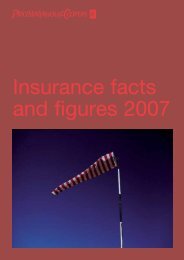Insurance - PricewaterhouseCoopers
Insurance - PricewaterhouseCoopers
Insurance - PricewaterhouseCoopers
You also want an ePaper? Increase the reach of your titles
YUMPU automatically turns print PDFs into web optimized ePapers that Google loves.
Reinsurance Management<br />
GPS 230 aims to ensure that a general insurer, as part of its overall risk management<br />
framework, has a specific reinsurance management framework to manage the<br />
selection, implementation, monitoring, review, control and documentation of<br />
reinsurance arrangements. These systems, together with the structures, processes,<br />
policies and roles supporting them, are referred to as a general insurer’s risk<br />
management framework. There must be a clear link between this framework and the<br />
insurer’s Reinsurance Management Strategy (REMS).<br />
The current GPS 230 requires that a general insurer:<br />
•<br />
•<br />
•<br />
•<br />
has in its reinsurance management framework a documented REMS, sound<br />
reinsurance management policies and procedures and clearly defined managerial<br />
responsibilities and controls;<br />
submits its REMS to APRA when any material changes are made;<br />
submits a Reinsurance Arrangements Statement (RAS) detailing its reinsurance<br />
arrangements to APRA at least annually; and<br />
makes an annual reinsurance declaration (RD) based on the “two-month rule” and<br />
“six-month rule” and submits the declaration to APRA.<br />
The concepts above; reinsurance management framework, REMS, RAS, RD and the<br />
“two-month” and “six-month” rules are explained below.<br />
Reinsurance management framework and REMS<br />
The reinsurance management framework should include both reinsurance and<br />
retrocession arrangements and have a clear link to the risk management strategy.<br />
It should include clearly defined management responsibilities and controls, policies<br />
and procedures to manage the selection, implementation, monitoring, review,<br />
amendment and documentation of reinsurance arrangements of the general insurer,<br />
and a written, board approved REMS.<br />
The REMS should document the objectives and strategy for reinsurance<br />
management including the risk appetite of the general insurer, the policies for setting<br />
and monitoring aggregate retentions and upper limits on policies, the methods for<br />
choosing appropriate reinsurance participants and the process used for setting and<br />
monitoring the MER. Members of global groups are expected to provide details of<br />
global reinsurance arrangements. The updated GPG 245 specifies that Category<br />
D insurer and Category E insurer should target to cede no more than 90% of their<br />
premium and for the other insurers the limit is 60%.<br />
The general insurer is also required to have this reinsurance management framework<br />
reviewed by operationally independent, appropriately trained and competent<br />
members of staff. The frequency and scope of this review will depend on the size,<br />
business mix, complexity of the insurer’s operations and the extent of any change<br />
62 | <strong>Insurance</strong> facts and figures 2009

















